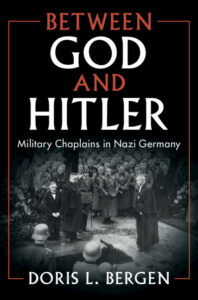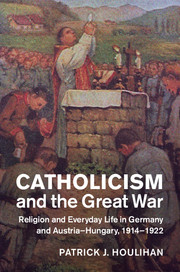Contemporary Church History Quarterly
Volume 29, Number 3/4 (Fall 2023)
Review of Doris L. Bergen, Between God and Hitler: Military Chaplains in Nazi Germany. Cambridge: Cambridge University Press, 2023.
By Martin Menke, Rivier University (mmenke@rivier.edu)
Doris Bergen is the Chancellor Rose and Ray Wolfe Professor of Holocaust Studies at Toronto. Her works on the Holocaust, War, and Genocide: A Concise History of the Holocaust and Twisted Cross: The German Christian Movement in the Third Reich are standard works in the field. In her most recent work, she studies the one thousand Christian chaplains in the Wehrmacht during World War II. (2) Specifically, she asks whom chaplains served during the war. Her answer is a few chaplains served the regime, most served the soldiers in their care, and virtually none served the victims of Germany’s wartime atrocities.
 Bergen first asks what chaplains knew about the annihilation of the Jews and whether or not they sought to intervene. Working with letters individual chaplains sent to their bishops, friends, and family, official Wehrmacht reports on the chaplaincy, and more, Bergen paints an expected but devastating picture. Bergen demonstrates that the chaplains she studied were committed to their pastoral duties as they understood them. The chaplains celebrated religious services, counseled individual soldiers, and accompanied soldiers sentenced to death by a German court-martial on their final way. Before the war, Bergen shows, the chaplains continuously sought to prove their relevance to the soldiers in the field, both to prove their Germanic manliness and to prove themselves worthy of serving at the front. As Lauren Faulkner Rossi showed in her work Wehrmacht Priests: Catholicism and the War of Annihilation, the chaplains were constantly fighting efforts by the national socialist regime to curtail their activities, including the wartime decision not to replace chaplains killed or wounded in action with other chaplains and appoint Nationalsozialistische Führungsoffiziere (NSFO), national socialist leadership officers, instead. (Lauren Faulkner Rossi, Wehrmacht Priests: Catholicism and the War of Annihilation (Cambridge: Harvard University Press, 2015)). Beyond the fear of the NSFO, Bergen shows the chaplains continuously sought to prove their relevance to the soldiers in the field, both to prove their Germanic manliness and to prove themselves worthy of serving at the front.
Bergen first asks what chaplains knew about the annihilation of the Jews and whether or not they sought to intervene. Working with letters individual chaplains sent to their bishops, friends, and family, official Wehrmacht reports on the chaplaincy, and more, Bergen paints an expected but devastating picture. Bergen demonstrates that the chaplains she studied were committed to their pastoral duties as they understood them. The chaplains celebrated religious services, counseled individual soldiers, and accompanied soldiers sentenced to death by a German court-martial on their final way. Before the war, Bergen shows, the chaplains continuously sought to prove their relevance to the soldiers in the field, both to prove their Germanic manliness and to prove themselves worthy of serving at the front. As Lauren Faulkner Rossi showed in her work Wehrmacht Priests: Catholicism and the War of Annihilation, the chaplains were constantly fighting efforts by the national socialist regime to curtail their activities, including the wartime decision not to replace chaplains killed or wounded in action with other chaplains and appoint Nationalsozialistische Führungsoffiziere (NSFO), national socialist leadership officers, instead. (Lauren Faulkner Rossi, Wehrmacht Priests: Catholicism and the War of Annihilation (Cambridge: Harvard University Press, 2015)). Beyond the fear of the NSFO, Bergen shows the chaplains continuously sought to prove their relevance to the soldiers in the field, both to prove their Germanic manliness and to prove themselves worthy of serving at the front.
At the heart of the study lies the chaplains’ response to the antisemitic atrocities occurring around them. Bergen shows that chaplains hardly ever wrote or spoke about massacres observed near their positions. Instead, Bergen convincingly argues, the chaplains focused their pastoral care on both active duty and wounded soldiers, often more intensely than the regime desired. Soldiers perceived the chaplains’ presence and pastoral to absolve the soldiers from any guilt incurred during combat but also in measures against the civilian population. (8, 10, 20) Bergen asks, “Were the chaplains Nazis? A more fruitful question asks how people who were not fervent Nazis or eager killers ended up playing an essential role in atrocity?” (15)
Bergen’s work contributes to current scholarly inquiry into the behavior of Christian clergy during the national socialist era. How did Christian clergy respond to national socialist persecution of minorities such as Jews and individuals with disabilities? One must find the military chaplains essentially wanting by today’s standards. Just as clergy in the Altreich, with exceptions, failed to protect Jews, military chaplains closed their eyes to the atrocities committed by the German armed forces. Already in 1933, the might be said about Christian leaders in general, such as Cardinal Faulhaber of Munich, who in 1933 argued that “Jew-Christians” (Judenchristen) could take care of themselves. (Ludwig Volk, Der Bayerische Episkopat und der Nationalsozialismus 1930-1934. Veröffentlichungen der Kommission für Zeitgeschichte, series B, vol. 1 (Mainz, 1965), 78: Nachlaß Faulhaber)) In addition to the concerns Bergen mentioned about manliness and loyalty, Faulhaber mentioned the fear that defending Jews might lead to the persecution of Catholics. The desire to avoid opposing national socialist policy prevailed among military chaplains as it did among most civilian clergy. See, in exemplary fashion, the work of Kevin Spicer. (Kevin Spicer, C.S.C., Resisting the Third Reich: Catholic Clergy in Hitler’s Berlin (DeKalb: Northern Illinois University Press, 2004) and Hitler’s Priests: Catholic Clergy and National Socialism (DeKalb: Northern Illinois University, 2008)). Also, military chaplains faced the additional burden of supporting troops on the front lines. She argues, “The Wehrmacht chaplaincy acted as an insulating layer, protecting German soldiers from listening to their consciences or reflecting on Christian teachings. The buffer also covered the chaplains themselves and absorbed objections they may have had. The chaplaincy became a cone of silence, a tunnel.” (20) It would have been challenging to warn those involved in atrocities of the sinful nature of their acts.
While Bergen’s argument makes sense, one wishes she had done more to explore subjects that might weaken her argument. Most importantly, putting pen to paper during the national socialist era was perilous. It would have been helpful to understand the chaplains’ reports and letters home in the context of military censorship of the mail from the front. Given the regime’s hostility to the chaplaincy, might the chaplains have been particularly concerned their mail would be intercepted and exploited? Bergen herself notes that clergy who contradicted the regime’s official line on the Kristallnacht pogrom found themselves barred from service as chaplains. (74) Bergen shows that the vetting process for chaplains sought to weed out any individual previously critical of the regime. As Bergen notes, this kept principled clergy from becoming chaplains, which led to a chaplain’s corps being more inclined to support the regime. Bergen might have displayed more understanding of the pressure chaplains felt to care for their assigned flock against the scrutiny of the regime. They focused on the soldiers in their units, to support them and provide them with solace, which they could not have done had they remonstrated with them about the atrocities German forces were committing.
Furthermore, with few exceptions, Bergen does not show direct awareness by chaplains of atrocities committed by German forces. “Many chaplains’ activity reports situate individual clergy squarely in the areas of major massacres of Jews, although they do not explicitly mention these events.” (123) A more detailed analysis of the stations at which Christian chaplains served at any given point during the war about the occurrence of atrocities would have been helpful. Beyond the data provided, a more detailed analysis of the distribution of Christian chaplains among Wehrmacht units would have been helpful.
Nonetheless, Bergen’s fundamental question remains valid: “Whom or what does a chaplain serve?” (2) A Christian clergy should first serve God and God’s commandments, regardless of nationality, ideology, etc. Seeing evil, or at least the evidence of evil, clergy should have interceded for the victims. Instead, and this Bergen might have emphasized further, the chaplains considered their mission limited to the welfare of German soldiers, not to all those they encountered. As a result, “In the Nazi empire, Christianity and Christian chaplains were essential components in a system of ideas, structures, and narratives that protected and rewarded the perpetrators of genocide and their communities even as it erased their victims and denied their crimes.” (232)

 Readers eager to expand their knowledge of World War II will appreciate details that are rarely addressed in standard histories. Reynolds, who served with the 120th Light Anti-Aircraft Regiment, describes how he experienced the elaborate preparations for the Normandy landings, including three days on board LST (Landing Ships Tank) 319. He also provides a fascinating glimpse into British interactions with locals in northern France and Belgium in the months after the breakout. For example, through a funeral he conducted for a Protestant civilian, Reynolds met and befriended a French woman, Mlle Perremond, who spoke excellent English. He subsequently learned that she and two other French women, one young, the other elderly, had helped seven downed RAF pilots escape to England.
Readers eager to expand their knowledge of World War II will appreciate details that are rarely addressed in standard histories. Reynolds, who served with the 120th Light Anti-Aircraft Regiment, describes how he experienced the elaborate preparations for the Normandy landings, including three days on board LST (Landing Ships Tank) 319. He also provides a fascinating glimpse into British interactions with locals in northern France and Belgium in the months after the breakout. For example, through a funeral he conducted for a Protestant civilian, Reynolds met and befriended a French woman, Mlle Perremond, who spoke excellent English. He subsequently learned that she and two other French women, one young, the other elderly, had helped seven downed RAF pilots escape to England. Röw’s intentions are to deliver a comprehensive structural and experiential history of Catholic military pastoral care in Germany, with a particular emphasis on providing a systematic study of chaplaincy (12). He has oriented himself solidly in the available historiography on the subject in both German and English and his archival research is impressively broad, gathering material from four archdiocesan archives (including Salzburg), eight diocesan archives (including one in Austria and one in the Netherlands), and several other state and private collections in Germany. His main source for primary documentation is the Archive of the Catholic Military Bishop, in Berlin, notably the Georg Werthmann collection. Until relatively recently, this rich compilation of chaplaincy-related material, produced by the man who served as second-in-command of the Catholic chaplaincy during the Second World War, was strikingly understudied; in the past four years, three books have appeared whose authors have extensively mined its records.
Röw’s intentions are to deliver a comprehensive structural and experiential history of Catholic military pastoral care in Germany, with a particular emphasis on providing a systematic study of chaplaincy (12). He has oriented himself solidly in the available historiography on the subject in both German and English and his archival research is impressively broad, gathering material from four archdiocesan archives (including Salzburg), eight diocesan archives (including one in Austria and one in the Netherlands), and several other state and private collections in Germany. His main source for primary documentation is the Archive of the Catholic Military Bishop, in Berlin, notably the Georg Werthmann collection. Until relatively recently, this rich compilation of chaplaincy-related material, produced by the man who served as second-in-command of the Catholic chaplaincy during the Second World War, was strikingly understudied; in the past four years, three books have appeared whose authors have extensively mined its records. Houlihan’s argument is that conventional interpretations of religion in the First World War, which emphasize the secularizing effect of a shattering war experience as expressed in the voices of cultural modernists, do not capture the experiences of German and Austro-Hungarian Catholics. Rather, he asserts that Catholics adjusted to industrial warfare because their transnational faith and its practices helped them to cope relatively successfully with the upheaval and brutality of war—more successfully than Protestants, whose faith (in the case of Germany) was more closely tied to the defeated state.
Houlihan’s argument is that conventional interpretations of religion in the First World War, which emphasize the secularizing effect of a shattering war experience as expressed in the voices of cultural modernists, do not capture the experiences of German and Austro-Hungarian Catholics. Rather, he asserts that Catholics adjusted to industrial warfare because their transnational faith and its practices helped them to cope relatively successfully with the upheaval and brutality of war—more successfully than Protestants, whose faith (in the case of Germany) was more closely tied to the defeated state.